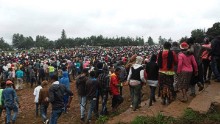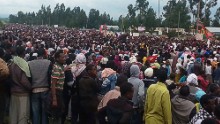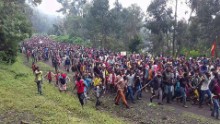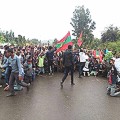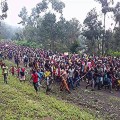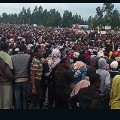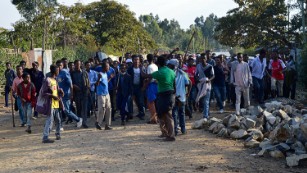
The demonstrations are crushed but anger remains in Bahir Dar, capital of Ethiopia's northern Amhara region, where a fortnight ago security forces killed at least 30 protesters, according to a human rights group.
"I would say at least 50 people!" said Getachew, a protester who saw bodies arrive at the city hospital on 7 August.
Dressed in black, Getachew is mourning his younger brother Abebe, 28, who he says was shot twice -- once in the back of the head and once in his side -- as Ethiopian security broke up the protests with gunfire and gas.
"The 'Agazi' were on the rooftops. They started to shoot in the crowd. The police was launching tear gas," Getachew said, referring to Ethiopia's feared special forces with their distinctive red berets who were deployed to help crush the protests in Bahir Dar.
As he spoke Getachew scrolled through photographs of victims - including his brother -- on his mobile phone.
Like many of the protesters, Abebe was wrapped in an old green, yellow and red Ethiopian flag, but without the central star imposed on the flag by the ruling Ethiopian People's Revolutionary Democratic Front (EPRDF) when it took power in 1991. The wearing of the old flag is a patriotic rebuke of EPRDF rule.
Getachew was one of the few willing to speak following the protests in Bahir Dar, and even he would not give his full name.
- Fear and mistrust -
This small, pretty town on the edge of Lake Tana and close to the source of the Blue Nile is still in shock after the killings. The tourist hotels are deserted, the tour guides idle and the fear of government reprisals is palpable.
"If I start talking in a café, the Kebele [local government officials] will know it. We cannot trust our neighbours or our friends," said one tour guide who did not want to be identified.
Since the demonstrations, arrests have multiplied, said Getachew. "Five friends of Abebe were arrested after they went to his funeral. We don't know where they are," he said.
In the village of Dangla, just south of Bahir Dar, resident Andualem said there had been security sweeps and stark warnings.
"They go door to door to give extreme warning not to go out to demonstrate otherwise you will be killed," said Andualem. "They say: Keep your children and your life."
Mobile internet and social networks have been blocked to prevent the predominantly young activists from the decentralised protest movement from organising further demonstrations.
Many of the young protesters are angry at a government that has been in charge for almost their whole lives and that is seen to favour the minority Tigrean community who occupy key positions in government, the security services and public companies.
"There is a tangible development. You can't deny the roads, the buildings, the power supply but the VIPs are all from Tigray. Tigreans dominate economically and socially. All the industries are in Tigray," said Ashenafi, a young Amhara protester.
- Ethnic federalism failing -
The government's decision to join the northern province of Welkait to the Tigray region was the immediate trigger for the Amhara protests, but they have occurred at the same time as others in the Oromo region where regular, sometimes deadly, demonstrations have happened since November over land rights.
Together, Oromo and Amhara people make up over 60 percent of the population.
The demonstrations are a challenge to the EPRDF's model of "ethnic federalism" intended to give representation and a degree of self-determination to the multitude of ethnic groups in Ethiopia.
"Ethnic federalism is not working because it is not implemented equally," said Molla Wasie of the opposition Agaw Democratic Party. "Things are getting more and more tense. The government and the opposition should come together and find a solution."
The Bahir Dar demonstrators are still angry. Following the protests, the authorities gave a low figure of just seven dead, while human rights group Amnesty International said 30 had been killed. Locals say the number was higher still.
"They did not apologise for the people killed. They do not feel guilty. All they say is that if somebody comes out, they will take action," said Ashenafi. "I do not see any sign that they will change."








